Etruria's Hidden Depths: The Mystical Journey Through Ancient Etruscan Tombs

Buongiorno and welcome to Stefano Rome Tours, Rome’s leading tour company for sightseeing tours in Italy, and Shore Excursions from Civitavecchia. Our signature Countryside Tours from Rome: Castles and Lakes, and Etruscan Mystery take you on fascinating adventures through Etruria - the historical land of the Etruscans - and explore ancient Etruscan tombs in Cerveteri and Tarquinia - both UNESCO World Heritage Sites.
Before we delve into Etruria’s hidden depths of their sacred tombs, let's begin with some introductory insights into the world of the Etruscans:
Where is Etruria?
Etruria was an ancient region in central Italy that existed during the Iron Age and Classical period from approximately the 8th century BC to the 3rd century BC. It was the homeland of the Etruscans, an ancient civilization that thrived in the area before the rise of Rome.
Geographically, Etruria encompassed a region that corresponds to modern Tuscany, parts of Umbria, and northern Lazio. The Etruscans established a network of city-states, with prominent centers such as Cerveteri, Tarquinia, Veii, and Vulci, each boasting distinctive characteristics in terms of art, architecture, and governance.
Who were the Etruscans?
The Etruscans were an ancient civilization that flourished in central Italy until they were conquered by the Romans during the 3rd century BC. Despite their significant impact on the development of early Italy, the Etruscans remain somewhat enigmatic, with many aspects of their culture, language, and origins still not fully understood.
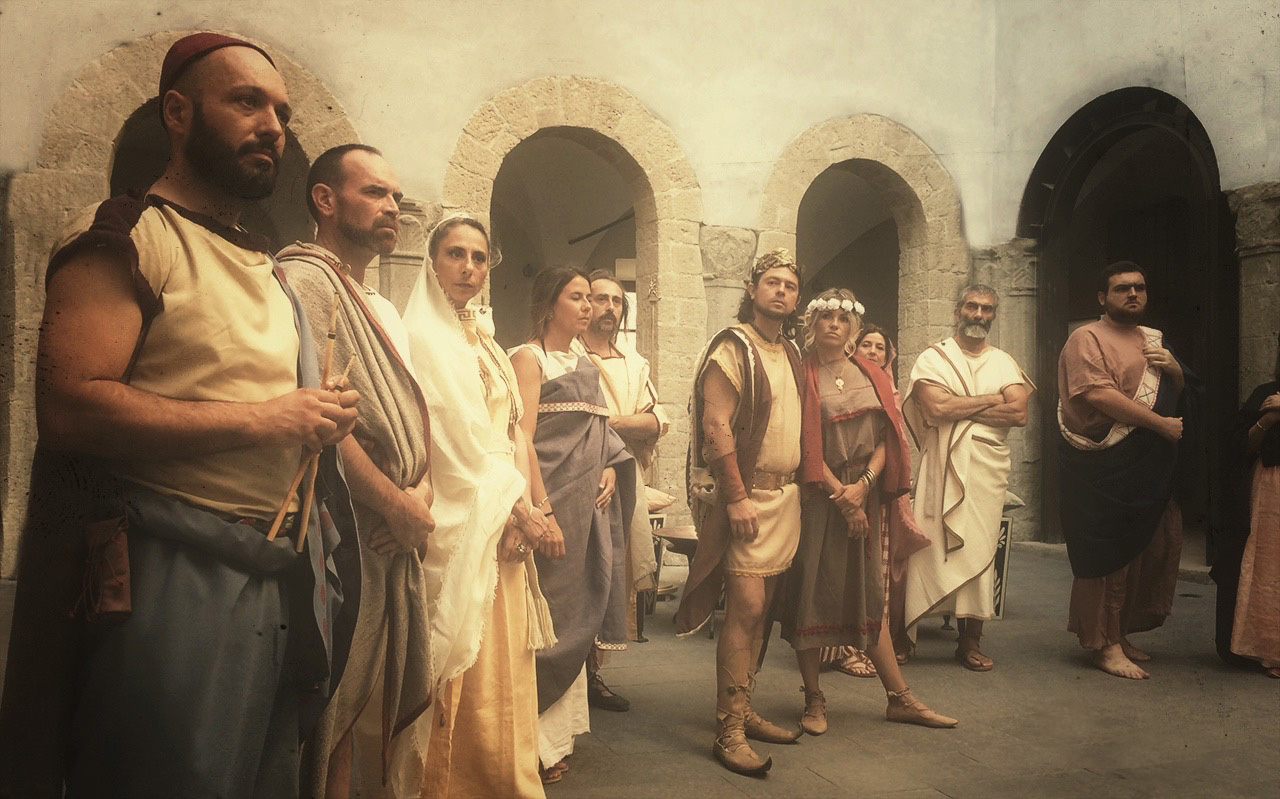
The Etruscans established a network of city-states, each governed by a local aristocracy. Notable among these city-states were influential centers such as Tarquinia, Cerveteri, Vulci, and Veii. These urban centers served as hubs of art, commerce, and political power, and the Etruscans developed a distinctive way of life characterized by sophisticated artistry, advanced metallurgy, and a deep connection to their religious beliefs.
One of the most enduring legacies of the Etruscans lies in their artistic achievements. Etruscan art is renowned for its vibrant frescoes, intricate pottery, finely crafted metalwork, and intricate jewelry.
The Etruscans were skilled engineers and architects, influencing the development of Roman architecture. Notably, the Romans adopted the Etruscan use of the arch, a key architectural feature that became a hallmark of Roman construction. Additionally, the Etruscans' use of the Tuscan order, a simplified form of the Doric column, also left a lasting impact on Roman architectural traditions.
In terms of governance, the Etruscans were organized into city-states, each ruled by a king or local aristocracy. The Romans, in their early stages, were significantly influenced by Etruscan political structures, adopting certain elements of Etruscan governance into their evolving republican system. In fact, Rome was ruled by 3 Etruscan kings before the Romans abolished monarchy and created the Roman Republic.
The decline of the Etruscans is a complex historical narrative, involving factors such as internal strife, external invasions, and the gradual expansion of the Roman Republic. By the end of the 3rd century BCE, the once-mighty Etruscan civilization had waned, and Etruria became assimilated into the growing Roman sphere of influence.
What was the Etruscan Religion?
The Etruscans held a deeply spiritual worldview, and their religious practices played a significant role in shaping their cultural and social life. Central to their beliefs was the idea that divine forces influenced every aspect of human existence.
Haruspicy, a form of divination involving the examination of animal entrails, was a prominent Etruscan religious practice, reflecting their belief in interpreting signs from the gods.
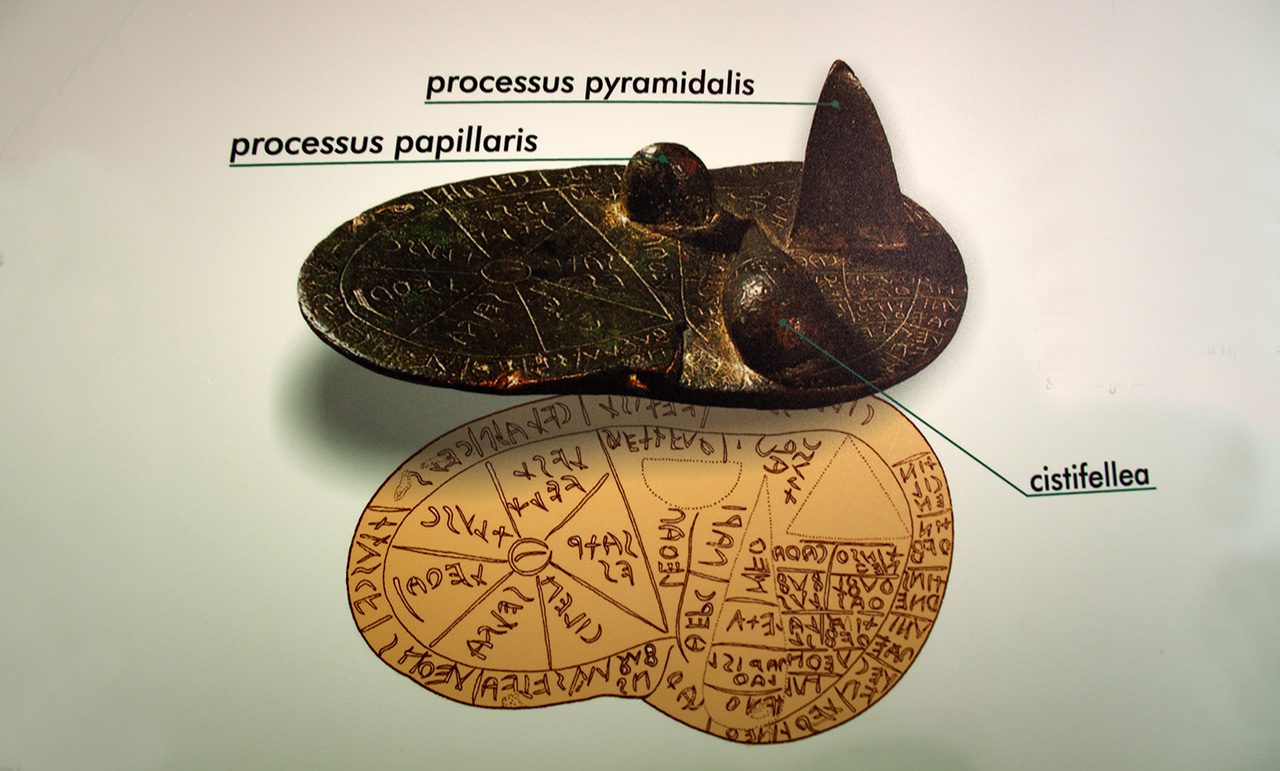
The Etruscans worshipped a pantheon of deities, including Tinia (equivalent to the Roman Jupiter), Uni (Juno), and Menrva (Minerva), among others.
Temples dedicated to these gods were constructed across Etruria, serving as centers of religious activity. Additionally, the Etruscans believed in an afterlife, and elaborate burial practices, including the construction of intricate tombs adorned with symbolic frescoes, underscored their profound connection to the spiritual realm. While the specifics of Etruscan religious beliefs remain enigmatic due to the lack of comprehensive written records, archaeological findings and artistic representations provide valuable insights into the rich religious traditions.
Now let’s proceed with our travel blog and delve into the hidden depths of Etruscan burial sites, unlocking the secrets of a civilization that believed in a profound connection between life and the afterlife.
Etruria's Hidden Depths:
The Mystical Journey Through Ancient Etruscan Tombs

Etruscan Funerary Rites and Beliefs
The Etruscans held unique and complex beliefs about the afterlife. Unlike their Roman counterparts, the Etruscans viewed the journey into the afterlife as a continuation of life's journey, not an end. For the wealthy Etruscans with the means to commission elaborate structures, their tombs were not mere repositories for the dead but rather homes in another realm, carefully designed to ensure a smooth transition into the next phase of existence.
Etruscan tombs, whether above ground or underground, carved into the rock or constructed from stone, were designed to mirror domestic structures. Many featured expansive chambers adorned with wall frescoes, stone benches, and urns shaped like houses or representations of the deceased. Tombs were furnished with items for the deceased along with their sarcophagi.
Funerary rites were elaborate, involving intricate rituals to honor the deceased and ensure their safe passage into the afterlife. Frescoes adorning the walls depicted scenes of banquets, dances, and everyday life, reflecting the Etruscans' belief that the deceased would continue to enjoy a life similar to the one they had known on Earth. It is believed that even gladiator combats began as Etruscan funerary games.
Banditaccia Necropolis: houses of the dead
The Banditaccia Necropolis, sprawling over approximately 400 hectares, stands as an awe-inspiring testament to Etruscan burial practices spanning from the Villanovan period (9th century BC) to the Hellenistic period (3rd century BC). Originating from a cluster of Villanovan tombs, the necropolis earned its name from being "banditated" or rented in the late 19th century.
As the largest ancient necropolis in the Mediterranean, Banditaccia Necropolis houses thousands of burials that resemble a city layout, featuring streets, small squares, and distinct neighborhoods. It encompasses various tomb types, including trenches cut in rock, tumuli, and rock-carved structures resembling huts or houses, exhibiting intricate structural details.

Evolution from burial pits to elaborate tombs
Within the necropolis, we also witness the evolution of tomb structures. Early and more primitive Villanovan era featured wells or burial pits, while the Orientalizing period introduced grand rock-cut mounds like the "Tomba della Capanna" and the "Tumulus Maroi".
In Etruria, mound burials are characterized by a circular tufaceous structure that contains a representation of the deceased's dwelling, complete with a corridor (dromos) connecting various rooms. These tombs, abundant in details, provide valuable insights into Etruscan domestic life.
Upon entering a tomb, one can almost sense stepping into a stone residence, complete with a gabled ceiling, stone-carved chairs or architectural elements, multiple rooms, and even "male and female beds" for the deceased.

The tombs’ entrances, marked by a carved doorway resembling the facade of a house, symbolize the threshold between the world of the living and the realm of the deceased. In fact, in painted murals, this symbolic door to the Underworld acted as a barrier between the kingdom of the living and the kingdom of the dead.
The deceased were laid to rest within stone sarcophagi each bearing intricate carvings representing the individual's identity, accomplishments, and perhaps even their aspirations for the afterlife. In other cases, the deceased were laid to rest on stone beds inside the tombs.
In the 5th century BC, cube-shaped tombs in blocks replaced mounds, as seen along Via dei Monti Ceriti and Via dei Monti della Tolfa which gives the impression of a city-like planning with blocks and roads. These pathways once traversed for funeral processions, still exhibit discernible grooves carved by centuries of carts used in these ceremonial journeys.
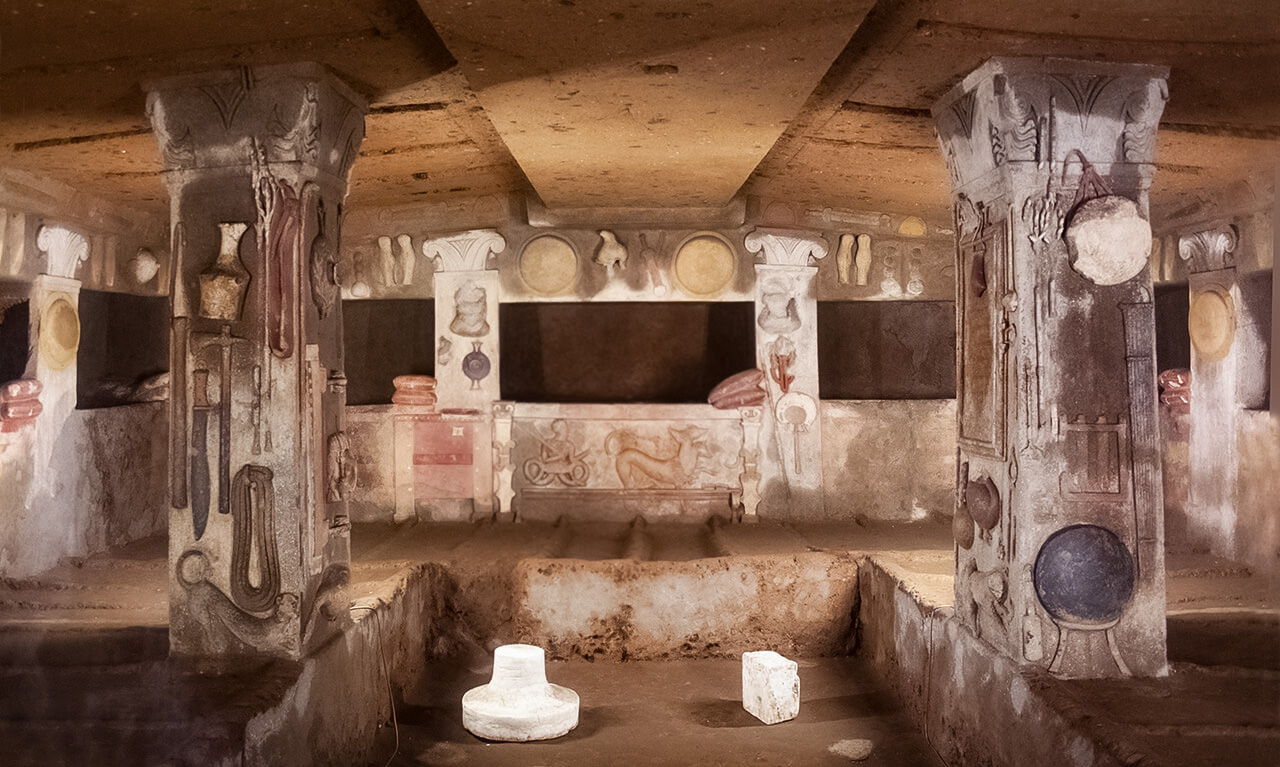
The underground Tomb of the Relifes (Tomba dei Rilievi), dating back to the 4th century BC and linked to the Matunas family, stands out for its exceptional preservation. While the tomb's interior, including painted reliefs on walls and columns, cannot be physically visited due to their delicate nature, they are visible through glass. These tombs offer a rare glimpse into Etruscan artistry and daily life which are also part of the Etruscans’ mystical journey into the afterlife.
Monterozzi Necropolis in Tarquinia - face to face with the Etruscans
The Monterozzi Necropolis in Tarquinia famous for its painted tombs, complements the rock-carved tombs of Cerveteri by offering a visual feast of frescoes that vividly depict the Etruscans' beliefs in the continuity of life beyond death. The painted tombs act as elaborate murals, capturing the essence of the Etruscans' lives and unique worldviews.

Etruscan Funerary Banquets and Celebrations
One of the most famous tombs, the "Tomb of the Leopards", is a masterpiece of Etruscan artistry, the funerary rites take on a celebratory tone. Two leopards, symbolic guardians of the afterlife, flank a central figure engaged in a lively dance. The vibrancy of the scenes and the joyous depiction of the departed underscore the Etruscans' conviction that the afterlife was not a somber existence but a continuation of the joy and vitality experienced in life.
The scenes of banquets, dances, and everyday life depicted in the frescoes of both necropolises illustrate the Etruscans' belief that the deceased would not only continue to exist in the afterlife but would do so in a manner reflective of their earthly experiences. The tombs, in essence, become portals that encapsulate the essence of Etruscan life, preserving the journey beyond art, symbolism, and belief.
Echoes of Change: Evolving Tones in Etruscan Tombs
As the Etruscans faced the grim prospect of their future amid the relentless expansion of the Roman Empire and the conquest of Etruscan city-states, a profound shift occurred in the artistic portrayal within the painted tombs of Tarquinia.
The transition from the joyous scenes witnessed in tombs like the "Tomb of the Leopards" and the "Tomb of the Jugglers" to the more ominous and sinister ambiance of tombs such as the "Tomb of Caronti" and the "Tomb of the Blue Demon" mirrored uncertainties and anxieties that accompanied the declining fortunes of the Etruscan city-states.

Both the Banditaccia and Monterozzi Necropolises showcase the Etruscans' commitment to intertwining the earthly and spiritual realms through their funerary practices. The elaborate tombs, whether rock-carved or painted, reflect the Etruscans' belief in the continuity of life beyond death. The meticulous attention to detail in the design of the tombs and the artistic representations within them underscores the sacred nature of these spaces.
Ancient Etruscan Tombs are Precious Time Capsules
By now we understand that Etruscan tombs were not mere repositories for the deceased but intricate spaces that blended the familiar structures of daily life with profound symbolism. These ancient tombs are invaluable archaeological treasures, preserving not only the physical remnants of a bygone era but also the intangible essence of a civilization's beliefs and values.
The artifacts within these tombs provide a wealth of information about the Etruscans' daily lives, societal structures, and, most importantly, their perspectives on death and the afterlife.
Most significantly, our understanding of the enigmatic Etruscans has been largely shaped by the wealth of grave goods discovered within their tombs. Among these findings are the intricately adorned sarcophagi housing the departed, personal artifacts intimately connected to the deceased, pottery, and an assortment of items carefully selected for their perceived importance in accompanying the departed on their journey into the afterlife. These grave goods not only offer a glimpse into the material aspects of Etruscan life but also serve as indispensable keys to unlocking the mysteries of their beliefs, rituals, and cultural practices.
The artifacts discovered in the burial chambers have been meticulously unearthed, restored, studied, and showcased in local museums in Tarquinia, Cerveteri, Rome, and beyond.
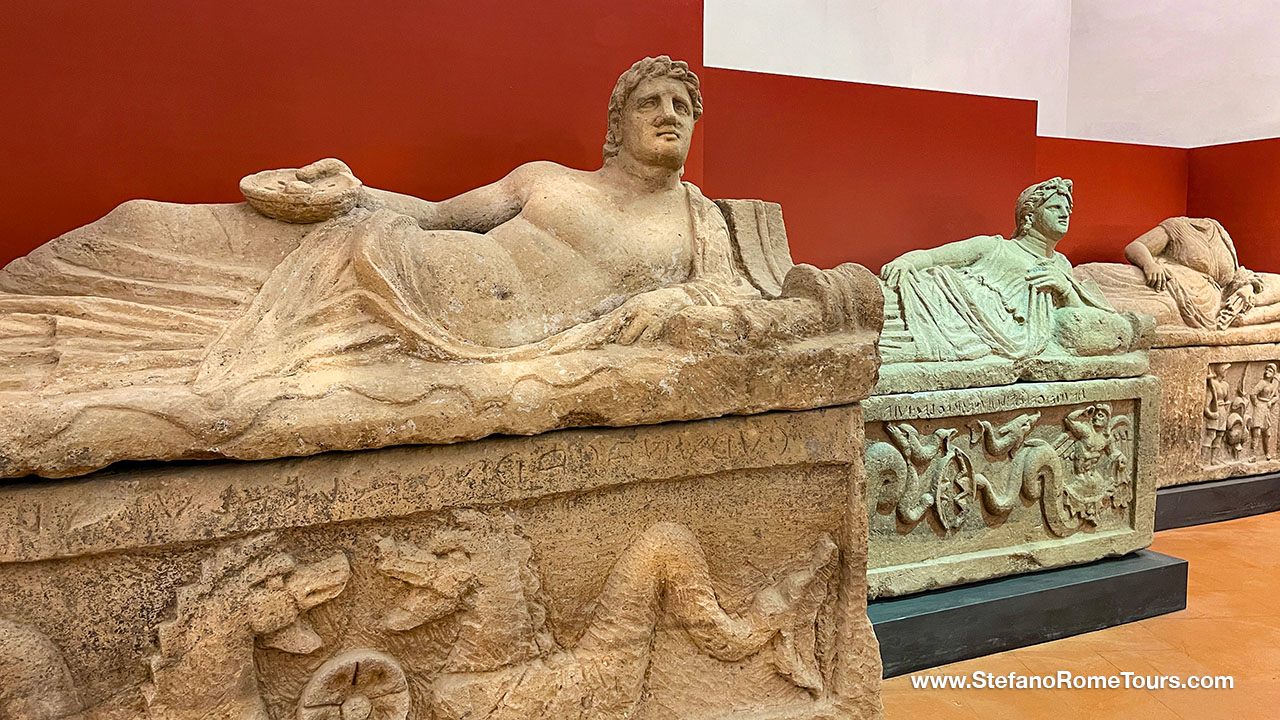
Ancient Etruscan Sarcophagi
Elaborate sarcophagi, intricately carved and often personalized, showcase the craftsmanship and artistic prowess of the Etruscans. Inscriptions on these sarcophagi offer glimpses into the individual's life, achievements, and perhaps most intriguingly, their aspirations for the afterlife. The sarcophagi lids often portray a sculpted or carved image of the deceased in their prime, sometimes even accompanied by a spouse.
One notable example of this is the "Sarcophagus of the Spouses", discovered in the Banditaccia Necropolis. This iconic artifact features a reclining couple, symbolizing the enduring bond between the departed. The intricate details of their attire, expressions, and gestures convey a narrative that transcends the boundaries of time. The accompanying inscriptions, though fragmentary, hint at the emotional connections and shared experiences of the couple.

However, not every individual had a sarcophagus; some were laid out on stone benches within the tomb. This choice reflected the diversity of burial practices among the Etruscans. Given the Etruscans' practice of both inhumation and cremation rites, the presence of cremated ashes and bones added another layer of complexity to their burial customs.
Depending on the era, the proportion of inhumation to cremation varied. In instances of cremation, the ashes and bones were carefully placed in urns crafted in the shapes of houses or representations of the deceased. This unique form of urn emphasized the Etruscans' belief in the continuity of life beyond death, infusing even the vessels holding remains with a symbolic connection to the deceased and their dwelling in the afterlife.
Symbols and Mythology in Etruscan Funerary Practices
The walls of Etruscan tombs in Tarquinia’s Monterozzi Necropolis are adorned with a pantheon of symbolic imagery and mythological scenes. The symbols employed not only reflect the Etruscans' religious beliefs but also underscore the importance they placed on ensuring a safe and harmonious transition for the departed.
Winged deities, with their celestial forms, symbolize the ethereal realm and the transcendence of the soul. Guardian spirits, depicted in various forms, stand as sentinels ensuring safe passage into the afterlife.
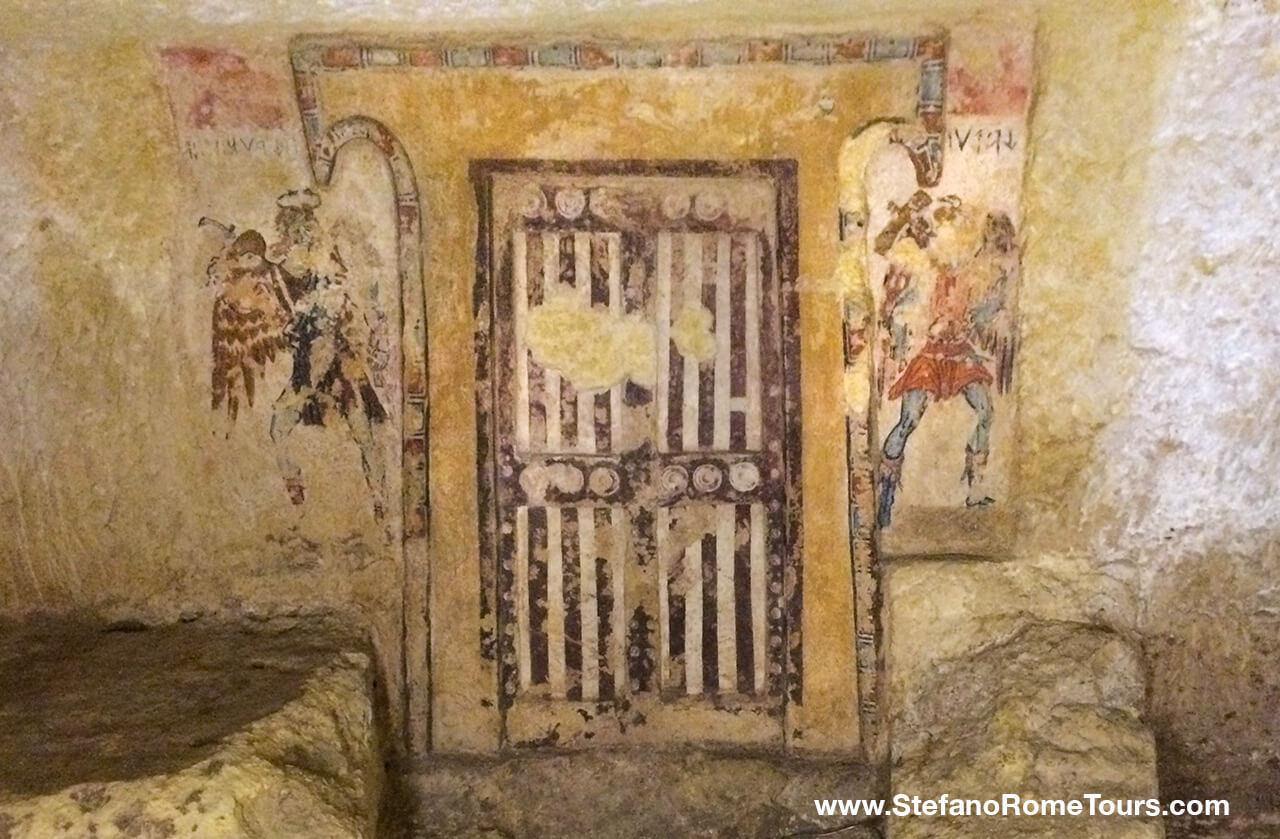
Charun, the formidable demon ferryman, prominent in Etruscan mythology, mirrors the Greek Charon's role in escorting departed souls across the river to the underworld. It’s important to note that the duty of Charun and Vanth was not to punish or frighten the deceased but to guide them to their final destination.
The display of eggs in the hands of the reclining banqueters in the tombs of the Lionesses and Leopards is a well-known symbol of immortality, the continuation of life after death in a spiritual realm.
The Legacy of Ancient Etruria
As we unravel the mysteries within Etruscan tombs, we gain a deeper understanding of the culture and spirituality that defined this ancient civilization. The Etruscans, though often overshadowed by the later Roman Empire, were a people with a profound connection to the metaphysical aspects of life. Their tombs, with their intricate frescoes, personalized sarcophagi, and symbolic motifs, serve as a testament to a society that sought to bridge the gap between the earthly and the divine.
In conclusion, the mystical journey through Etruria's ancient tombs offers us a unique opportunity to transcend time and connect with a people whose beliefs and practices have long been shrouded in the mists of history. We are reminded that the Etruscans, in death as in life, sought not just preservation but a continuation of the journey into the unknown, leaving behind a legacy that continues to captivate and inspire.

You too can enjoy a mystical journey through the ancient Etruscan tombs in Cerveteri and Tarquinia on our Rome Countryside Tours and experience the wonders of this ancient mysterious civilization.
We invite you to browse through our tours on our website where you will discover a vast collection of exciting Rome Tours, Day Tours from Rome, and Shore Excursions from Civitavecchia to some of Italy’s top destinations.
We look forward to sharing with you amazing places in Italy!
